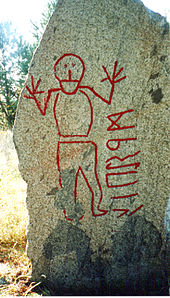Krogstasten
The Krogstasten ( U 1125 ) is a rune stone that stands in its original location in the northern part of the Krogsta burial ground, about one kilometer north of the church of Tuna , on the road to Nyvalla in Uppland in Sweden . Johannes Bureus (1568–1652) examined the stone as early as 1594.
The rune stone erected in the 6th century is the oldest in Uppland and inscribed with runes in the older Futhark . On one side is a human figure in adoring posture (with arms raised and fingers spread). The depiction is reminiscent of adorants on the rock carvings of the Bronze Age , such as the so-called "shoemaker" from Backa ( Swedish Skomakaren i Backa ). The figure may have been created as a deterrent. The granite stone has a triangular cross section. The height is 1.7 m with a width of 1.3 m at the base. The rune height is about 14 cm. The inscription is applied on two sides, written with so-called mirrored or turning runs, which are read from the back.
The inscription
The lettering is difficult to interpret. The first detailed description comes from Johan Nordenfalk in 1858. More has been written about a few rune stones than about the Krogstasten. The inscription on the front reads "mwsïeij". A convincing interpretation has not yet been achieved despite various approaches (e.g. acceptance of different encodings, use of term runes). Most runologists note that the only legible part of the inscription is on the side and reads “sïainaz”, which can be read as “stainaz” (“stone (s)”).
literature
- Klaus Düwel: Runic lore . 4th edition. Metzler, Stuttgart, Weimar 2008, ISBN 978-3-476-14072-2 .
Web links
- Description, photos
- Tuna 31: 1 (2) - entry in the database "Fornsök" des Riksantikvarieämbetet (Swedish)
- Description swed.
Coordinates: 60 ° 1 '49 " N , 18 ° 4' 14.1" E
